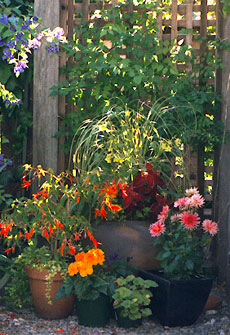|
|

|
Plant a Long-Lasting Bouquet in a Pot
The quick and easy way to add seasonal color to your garden is to plant flowering plants in pots. Thereís no digging involved, no competing plants to shade them out, and you can set pots anywhere you will enjoy them.
In planning your pot garden, go bigóthe bigger the pot the more plants it will hold and the richer your living bouquet will be. Thereís a practical side to bigness too: large pots donít dry out as fast as smaller ones.
To compose your big pot bouquet, spend some time shopping at the nursery. Hold one plant against another to see if their colors, shapes and sizes go together, just the way you put together an outfit.
Pick Special Plants for Special Purposes
Choose plants from these categories for four levels of color.
- Uprights: Select one or more upright plants, twice the height of the pot. Good candidates are flowering maple (abutilon), hydrangea or fuchsias for partial shade, buddleia, purple princess flower or hibiscus in sunny spots. Donít overlook all-season foliage plants like variegated pampas grass, and colorful New Zealand flax.
- Fillers: These plants are shorter than the upright plant, usually 12 to 18 inches high and filled with foliage that will hide the bare stems of most uprights. Flowering annuals are ideal: begonias, nemesia, salvia, sweet William, marigolds and zinnias. Choose plants with different flower sizes, colors and shapes. Foliage plants such as hostas, ferns and grasses make great fillers, too. Pick two or more different kinds of fillers.
- Fluffers: These are dense, fluffy plants that billow over bare soil and stems. Because they are not stars, but supporting players, they should have small leaves and flowers, like lobelia and sweet alyssum. Also great are Swan River daisies, bacopa, and variegated glechoma. Choose one or two fluffers.
- Drippers: These are plants that drape over the edge of the pot and continue the color show between pot rim and the pavement. Consider variegated ivy, asparagus ferns, lotus, million bells and those new sweet potato vines, one with black leaves, another with chartreuse leaves.
Planting Tricks and Techniques
Arrange your plants, still in their nursery pots, the way you will plant them in the pot. The upright will usually be at the center back of the pot, with fillers and fluffers flanking it and drippers at the outer edges.
Fill the pot with moistened potting soil up to the depth of the longest rootball, allowing for one-half to one inch of space at the top of the pot. Pat the soil to firm it and set your biggest plant--itís usually the uprightóin place.
Then fill the pot with soil to the depth of the next longest rootball, and place those plants into position. If the roots are tangled and circling the rootball, gently loosen them.
One trick for getting more plants into the pot and creating the effect of abundance is to reshape their rootballs: gently poke and press the rootball with your fingers so it is longer and slenderer than before.
As you plant filler and fluffer plants, leave an inch of space between the rootballs and around the outside edge of pot. Fill in with soil between rootballs using fingers or a bamboo chopstick to fill in small spaces.
Sprinkle in a time release fertilizer as you fill up the pot to the top of the rootballs. This is the most convenient way to provide pot plants the fertilizer they need for top performance since other fertilizers are washed out by the frequent watering pots get. After filling up, water well, using a gentle sprinkle and making several passes. If the soil mix sifts down, add more so the soil is level with the tops of the rootballs.
With regular watering and grooming your pots will provide color all season long. Feel free to trim or replace plants if they fade. For a party, get a pot or two of something in full bloom and add it to a planted container. If the foliage in the pot is dense enough, you can simply set the blooming plant, pot and all, on the soil. Just remember to water it more frequently than the big container.
|
|

